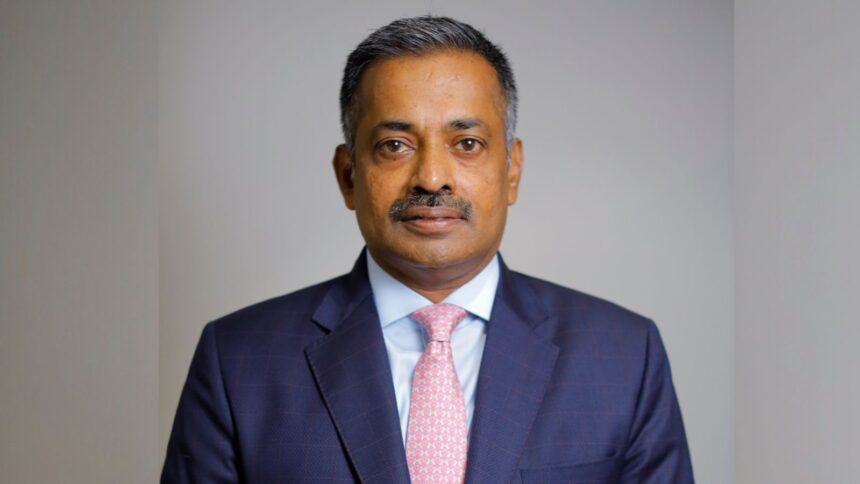B Gopkumar, managing director and chief executive officer of Axis Asset Management Company, says that the 15-25 per cent correction in frontline indices between October 2024 and February 2025 has made domestic market valuations more ‘reasonable’. In an interview with Hitesh Vyas, Gopkumar, who manages assets worth Rs 3.32 lakh crore, says that at a growth rate of 6-6.5 per cent, India remains the fastest-growing economy among major global economies. He expects private capex to pick up from the second quarter of the current fiscal year. Edited excerpts:
What is your assessment of the current market situation?
Whenever conflicts arise, equities typically react negatively. However, once the conflict subsides, markets tend to respond positively. This . Historically, markets have shown a recovery from such conflicts within a short time frame.
India’s strong macroeconomic framework positions it well during these times. With better terms of trade compared to other countries, a lower current account and fiscal deficit, reduced crude oil prices, and a consumption-driven economy, India remains resilient.
Looking at the current market scenario, from the lows observed around the end of February 2025, equities have impressively recouped approximately three-fourths of their losses. Mid- and small-caps have surged by 19-20 per cent since February 2025, while the has climbed 13 per cent. The 15-25 per cent correction in frontline indices from October 2024 to February 2025 has rendered valuations more reasonable. In the past two months, we have witnessed inflows from Foreign Institutional Investors (FIIs), while Domestic Institutional Investors (DIIs) have continued to lend their support.
There are two to three things. One is the global issues in terms of tariffs. There is still a lack of clarity on how it will pan out and what would be the impact on India. There are theories saying that it may not have a major impact as our exports to the US are not very high. Pharma and IT are some of the areas where we need to wait and watch.
Even corporates in the US are in a wait-and-watch mode as they are still analysing the impact of tariffs on their overall margins and how much they can pass on to end-users. We need to wait for the fine print of the bilateral trade agreement (BTA) between India and the US. The UK-India BTA, which was signed a few days earlier, was much broader and clearer.
Two, the geopolitical tensions that are happening. The third important thing is the corporate earnings. The corporate earnings have not been great for the last four quarters. Even for the last quarter (Q3 FY25), the earnings growth estimate for Nifty companies was mid-teen double-digit growth, but we ended with a higher single-digit number.
In the first quarter (Q1 FY25), people did not believe the (earnings) number, but in the second quarter, reality struck everyone. I am of the view that markets react to corporate earnings.
We do believe that from the second quarter (Q2 FY26) onward, a revival in the economy should happen in a better way as liquidity in the system is very good and the ability of banks to lend is now faster.
In Q1, we are seeing stress, and markets are also going to remain very volatile due to factors such as tariffs, geopolitical issues and weak corporate earnings. We also need to see how the monsoon shapes up. Last year we had a great monsoon, and the agricultural output was as per the expectations. The rural economy is doing fairly well. Urban consumption goes through a cycle, but we see pockets of growth. Real estate is one thing that is a proxy to the urban economy, and it is doing well after a three-year lull. When real estate does well, the economy does well.
Overall, what is your view on the current market valuation? Do you see it fairly valued or excessively valued?
Post the recent correction in the markets, we see valuations to be fair. I think there is still room for improvement in the pockets of sectors. One should not look at the valuation from a Nifty perspective, but also consider from a stock-specific viewpoint. Some stocks that were trading at 80-90 times, have substantially corrected, and are now below 40 times. There is no change in the business model, but underlying economy numbers have changed, and hence, the valuations have changed.
I think you still have growth at 6-6.5 per cent. There can still be a debate on whether a 6-6.5 per cent growth rate is good for the size of our economy or not. However, when you compare with other global economies, I think India is the fastest growing…there is no debate on that.
There is a huge amount of liquidity in the system. The new RBI regime has ensured sufficient liquidity in the system. I think interest rates should have a downward trend from here on, which is helpful for the economy. Lower interest rates can also prove good for assets like equities.
Given the uncertainty around tariffs and other geopolitical tensions, when do you expect private capex to pick up?
My view is that it might pick up from the second quarter (Q2 FY26) onward. With this kind of uncertainty, I don’t think companies will start investing. Nearly 80-85 per cent of the flows into fixed income schemes are from large corporates. This is a proxy to understand the capex cycle. When the capex cycle comes off, you generally don’t see money flowing into fixed-income products.
How do you view large-, mid- and small-cap stocks?
When considering areas of comfort in the market, it’s essential to compare large, mid, and small caps. Currently, there is a sense that valuation comfort remains in large-cap stocks. When the market undergoes corrections, money tends to flow based on valuation perspectives, and we are somewhat more inclined towards large-caps at the moment.
However, we also recognise that there are opportunities in midcaps. On the small-cap side, we manage the fifth-largest small-cap fund, with assets totaling nearly Rs 24,000 crore. Our liquidity profile for small caps, which is reported monthly, shows that we are among the most liquid in terms of exits for large assets under management (AUM).
Markets will go through cycles. If one wants to create wealth, it is important to do asset allocation. As long as one has a diversified asset allocation, it is expected to work well. One’s ability to hold long-term is also an important factor.
How do you view the market in 2025?
There are a lot of (IPO) mandates, but they are seeking higher valuations, and the market is not conducive to giving that valuation. A lot of companies have now said that they will not go to public markets but instead raise money through private equity. Post the second half of the current fiscal, things should improve. You will see a couple of IPOs coming in from the second quarter onward because there will be stability in India’s as well as global economic factors.
In the March quarter, DIIs surpassed FIIs in ownership of Indian companies. How do you see this trend playing out going forward?
If you look at the fourth quarter (of FY25), most of the mutual funds were sitting on huge cash. The average cash holding in some of the fund houses was at least 12-13 per cent. We had to wait and watch for February and March in terms of taking larger bets. Now, the cash levels are much lower as we are seeing funds getting deployed. This is one of the reasons why you see DIIs’ participation going up.
FII flows are a function of the rupee-dollar equation and the movement of US yields. As long as that is stable, you may find FII flows coming in. The flight of money went off when the rupee was at 86.5. Now, FII flows have started coming in because the dollar has corrected. This trend may continue because DII flows are good.
Where are the fresh inflows being deployed by the mutual fund industry?
First, one needs to be very close to the index as index weightage is important. Then we need to decide the overweight and the underweight. Currently, most of the allocations are going to the financial services. Apart from the financial services sector, inflows are seen in the consumer discretionary and manufacturing sectors.
What is the total AUM?
Our total AUM is close to Rs 3,32,000 crore as on May 8, 2025. Of which, equity AUM is around Rs 2,00,000 crore and the balance is fixed income. We are the 6th largest in the equity fund and fixed income segments. Overall, we are the 8th largest AMC in terms of AUM.








